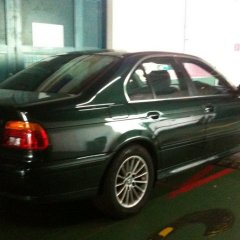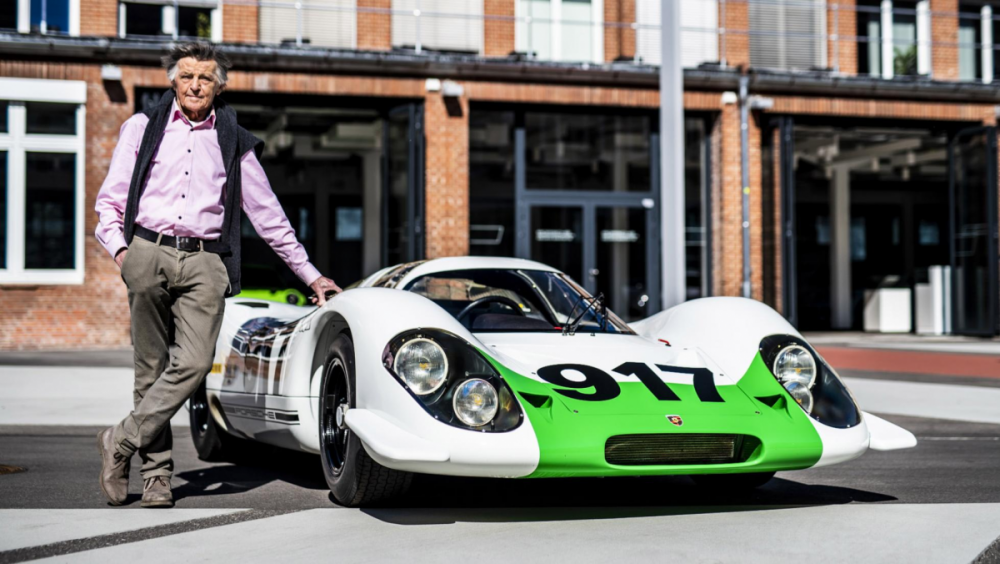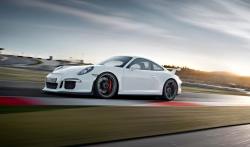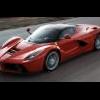Search the Community
Showing results for tags 'porsche singapore'.
-
Since there is no Porsche Thread. Let this be it. Share your experience on your Porsche as well as AD's service and standards
-
https://www.autoblog.com/2018/12/27/porsche-taycan-pricing-report/
- 53 replies
-
- 1
-

-
- porsche
- #porschetaycan
-
(and 5 more)
Tagged with:
-
Coupé or Cabriolet? Targa: The Best of Both Worlds Porsche completes its sports car trio in time for summer: following on from the Coupé and Cabriolet, the third body variant of the new 911 generation now makes its debut with the all-wheel drive Porsche 911 Targa 4 and 911 Targa 4S models. The distinguishing feature of the Targa remains its innovative, fully automatic roof system and, just like the legendary original Targa model from 1965, it features a characteristic wide roll hoop, a movable roof section above the front seats and a wraparound rear window. The roof can be comfortably opened and closed in just 19 seconds. It is powered by a six-cylinder, three-litre boxer engine with twin turbochargers: the Porsche 911 Targa 4 now delivers 283 kW (385 PS) and, in combination with the optional Sport Chrono package, accelerates from zero to 100 km/h in just 4.2 seconds - one tenth faster than before. The engine in the 911 Targa 4S boasts 331 kW (450 PS) and reaches the 100 km/h mark in just 3.6 seconds under the same conditions - four tenths faster than its predecessor. Top speed of the 911 Targa 4 is 289 km/h (up two km/h), while the 4S peaks at 304 km/h (up three km/h). Both sports cars are fitted with eight-speed dual-clutch transmission (PDK) and intelligent all-wheel drive Porsche Traction Management (PTM) as standard to deliver maximum driving pleasure. Alternatively, the 911 Targa 4S can be ordered with the newly developed seven-speed manual gearbox, with which the Sport Chrono package is included. New technology has also been integrated to extend the range of features for both 911 models and, for the first time, Porsche InnoDrive, which includes adaptive cruise control, is available. Thanks to the enhanced Smartlift function, ground clearance can be programmed so that it is raised for everyday use. The list of options is supplemented by an extensive range from Porsche Tequipment and new personalisation options from Porsche Exclusive Manufaktur. Porsche will further extend the combination of traditional style elements, timeless design and cutting-edge technology in a special edition of the 911 Targa, which will make its debut in June. Efficient biturbo boxer engine Like the 911 Carrera models, both Porsche 911 Targa variants profit from the increase in power provided by the turbocharged three-litre six-cylinder boxer engines. Both performance and everyday usability benefit as a result. The engine in the 911 Targa 4 produces 283 kW (385 PS) at 6,500 rpm, which is 11 kW (15 PS) more than its predecessor. Maximum torque of 450 newton metres is delivered across a wide engine speed range of between 1,950 and 5,000 rpm. With 331 kW (450 PS), the 911 Targa 4S delivers 22 kW (30 PS) more output than its predecessor and generates maximum torque of 530 Nm (up 30 Nm) between 2,300 and 5,000 rpm. Optimised all-wheel drive for better traction The enhanced performance of the new all-wheel drive models goes hand-in-hand with further development of the front-axle drive. The clutch and differential unit is water-cooled and has reinforced clutch discs for greater robustness and a higher load capacity. The increased actuating torque at the clutch improves its adjustment accuracy and the function of the additional front-axle drive. Overall, the enhanced front-axle drive with PTM (Porsche Traction Management) contributes to even better traction in all road conditions. Further developed chassis for more comfort and safety The electronically controlled variable damping system PASM (Porsche Active Suspension Management) is part of the standard equipment on the new 911 Targa models. This system automatically adjusts the damping characteristics in terms of driving comfort and handling to each driving situation and has two manually adjustable maps, Normal and Sport. Porsche Torque Vectoring Plus (PTV Plus), which includes an electronic rear differential lock with fully variable torque distribution, is added as standard equipment for the Targa 4S and is available as an option on the Targa 4. Like the other eighth generation Porsche 911 variants, the Targa models are also equipped with Porsche Wet mode as standard. Sensors fitted in the front wheel housings are capable of detecting water on the road surface and, if significant volumes of water are picked up, a signal in the cockpit provides a recommendation for the driver to manually switch to Wet mode. The drive responsiveness is then adapted to the conditions to guarantee maximum driving stability. The driving dynamics setup for the 911 Targa 4 includes 235/40 ZR tyres on 19-inch alloy wheels on the front axle and 295/35 ZR tyres on 20-inch wheels on the rear axle. As standard, the 4S model is fitted with 245/35 ZR tyres on its 20-inch front wheels and 305/30 ZR tyres on its 21-inch rears. On the Targa 4, deceleration is taken care of on both axles by 330-millimetre brake discs with black four-piston monobloc fixed callipers. The red-painted brake callipers on the Targa 4S have six pistons at the front axle, four at the rear while its discs measure 350 mm front and rear. The Porsche Ceramic Composite Brake (PCCB) can be ordered as an option. Extravagant Targa design with a modern interpretation The exterior of the Porsche 911 Targa is characterised by the design elements of its 992 model generation. Compared to its predecessors, its body features significantly more pronounced wheel housings at the front and, between its LED headlights, its bonnet has a distinctive recess evoking the design of the first 911 generations. Its rear is dominated by its wider, variably extending rear spoiler and seamlessly integrated, elegant light bar. With the exception of the front and rear sections, the entire outer skin is made from aluminium. The interior echoes the 911 Carrera models and is characterised by the clear and straight lines of its dashboard and its recessed instruments. The 911 models from the 1970s provided the inspiration here. Alongside the central rev counter - very much a defining feature for Porsche - two thin, frameless freeform displays extend the information provided to the driver. A compact switch unit with five buttons for direct access to important vehicle functions is located below the 10.9-inch centre screen of the Porsche Communication Management (PCM). The standard PCM features include online navigation based on swarm data as well as Connect Plus with Apple Car Play. The model for a new class of sports cars since 1965 The 1965 911 Targa 2.0 was a trailblazer for a whole new type of car. Originally marketed as a "safety cabriolet with anti-roll bar", the Targa, with its detachable roof, soon established itself as an independent concept and indeed became a style icon. Right through to the present day, Porsche has continued to combine two worlds in the 911 Targa: the advantages of open-top driving in a cabriolet combined with the everyday comfort and safety of a coupé. Prices The new Porsche 911 Targa models will be launched on the market from August 2020. Prices (including 19 percent VAT and country-specific equipment) start from 128,486 euros for the 911 Targa 4 and from 143,956 euros for the 911 Targa 4S.
- 30 replies
-
- 11
-

-
May i know following for 10yr+ 987.2 Boxster Tip: 1. Annual maintenance cost 2. Cost to replace IMS bearings and rear main seal? Thanks in advance!
- 56 replies
-
https://www.topgear.com/car-news/motorsport/legendary-porsche-engineer-hans-mezger-has-died Hans Mezger, the legendary Porsche engineer, has passed away aged 90. Mezger was born in a small village near Porsche’s hometown of Stuttgart in 1929. He started working for the company in 1956 after graduating from what is now the University of Stuttgart, having avoided being enlisted by the German military just weeks before the end of World War Two. He wouldn’t retire until 1993. Mezger was part of Porsche’s first Formula One programme in 1960. Soon after he developed the 901 air-cooled flat-six that powered the first-generation 911, and would inform the design of all 911 engines until the water-cooled 996. Then in 1965 he was put in charge of “race car design”, where he was ultimately tasked with winning Le Mans… The result was the 917 – Mezger was responsible for its “overall construction”, and the chief architect of its flat-12, which would go on to produce over 1,000bhp in the turbocharged Can-Am cars. Mezger got into turbocharging in a big way in 1974 when he began sticking blowers on 911s. The Can-Am 917s and 911 RSR influenced the road-going 911 Turbo, which in turn led to the turbo’d flat-six that would power the 935, 956 and 962 among others and bring Porsche many, many race wins. When Porsche fans talk about the ‘Mezger engine’, they’re usually referring to the water-cooled flat-six developed for the 996 and 997-era 911 GT3, GT2 and Turbo. Though these cars came out years after Mezger retired, this engine can trace its roots right the way back to his race-winning flat-sixes of the Seventies. The last 911 to use this engine was the epic 997 GT3 RS 4.0. Despite all of that, Mezger said the project he was most proud of was the 1.5-litre turbocharged V6 Porsche developed for the McLaren Formula One team in the Eighties. It won 25 races, two Constructors’ Championships and three Drivers’ Championships (one for Nicki Lauda in 1984, and two for Alain Prost in ’85 and ’86). Michael Steiner, Porsche’s R&D and motorsport boss, said: “We thank Hans Mezger for his extraordinary engineering achievements, which he has done for motorsport in general and for Porsche in particular. His innovations for our series sports cars will remain unforgotten forever.”
- 2 replies
-
- 2
-

-
- hans mezger
- porsche
-
(and 1 more)
Tagged with:
-
https://www.motor1.com/news/427097/oliver-blume-volkswagen-boss-rumor/ Skoda's boss could replace Oliver Blume at the helm of Porsche. The Volkswagen core brand is facing some major problems with two key products – the ID.3 and the Golf 8. Software issues are the culprit in both cases, and while deliveries of the electric hatchback haven’t technically been delayed (yet), the already built cars are in need of a software update before being shipped to customers this summer. As for the Golf, the situation is worse as customer deliveries have actually been halted, with Skoda doing the same with its mechanically related Octavia. In this context, Auto Motor und Sport is reporting some major personnel changes are set to take place at the top of the VW hierarchy. It appears Porsche's CEO Oliver Blume will move to lead VW and help the brand deal with the issues that have plagued the ID.3 and Golf 8. If the rumor is accurate, it means Herbert Diess will step down from his current role as head of VW, but will remain chairman of the VW Group. Oliver Blume’s role at the helm of the Stuttgart brand will allegedly be taken by Bernhard Maier, currently the man in charge at Skoda. It wouldn’t be his first job at Porsche as he joined the sports car marque in June 2001 to manage the sales division in Germany before being appointed in April 2010 as the boss of sales and marketing. In November 2015, Bernhard Maier was appointed as Skoda’s CEO. This management reshuffle within the Group could also impact Jochen Sengpiehl, Chief Marketing Officer of the VW brand. AMS reports he could lose his job in the wake of a racist ad for the Golf 8 published on social media. VW took down the controversial video and apologized for the unfortunate ad, vowing to investigate what went wrong. Reuters got in touch with VW to confirm or deny the report published by AMS, but the company refused to comment.
- 15 replies
-
- 1
-

-
Porsche Offers Modern Infotainment Systems For Classic 911 Models source: https://www.motor1.com/news/414490/porsche-modern-infotainment-classic-models/ First-generation Boxsters can get an upgrade, too. There’s no denying that Porsche has some of the most passionate auto fans in the world. Credit for that legacy certainly falls to the 911 – these owners love their cars and they love to drive them, be it a new 911 Turbo S or a classic air-cooled model from decades past. A few years back, Porsche Classic offered a neat upgrade for classic 911 owners in the form of a single-din infotainment system, bringing fresh tech to old classics. Now, Porsche Classic has updated that design and created a super-sized expansion with a new double-din unit. Called Porsche Classic Communication Management (PCCM), the newest offerings bring more tech options to old models with a single-din space in the dash, or straight-up modern tech to "young classics" starting with the 996 generation that have double-din systems. Regardless of the size, both systems offer Apple CarPlay, DAB +, and Bluetooth connectivity as well as navigation features. The larger double-din unit is called PCCM Plus. It’s designed to be a plug-and-play system that works with existing controls in the car, while also offering touchscreen functionality through a 7-inch screen. The upgraded technology for PCCM Plus also means those young classics drivers can take advantage of Porsche’s latest navigation systems with Porsche points-of-interest and route guidance. It’s not just for the 911 either – Porsche says this unit will work in the first-generation Boxster as well. The upgraded single-din design for older Porsches isn't quite as capable, but it still offers impressive capability for its size. In addition to navigation functions, the new PCCM offers DAB + and Apple CarPlay capability as well as a 3.5-inch touch-sensitive display. Primary functions are controlled through rotary knobs and integrated buttons, with the overall design mimicking classic Porsche stereo systems as closely as possible. The upgraded PCCM single-din unit is now available at a cost of €1,439.89 ($1,551). The larger double-din PCCM Plus model sells for €1,606.51 ($1,731). Both are available at Porsche centers or online in the Porsche Classic shop. Source: Porsche
- 22 replies
-
- 4
-

-
Some Dutch Engineering Students Built This Mid-Engine Shooting Brake From An Old Boxster Source: https://flatsixes.com/cars/porsche-boxster/some-dutch-engineering-students-built-this-mid-engine-shooting-brake-from-an-old-boxster/?fbclid=IwAR0Uk2nBKdPTcxw9wFFsvkeVBmBIwiG3ROAT-ksdb0_eBXoNBFXqEnLxOzA Four students at the Fontys Minor Motorsport Engineering school in the Netherlands have built the car that Porsche is afraid to because it has too much awesome in one package. Porsche's Boxster and Cayman are already amazing platforms, and are quite easy to live with on a daily basis. I daily drove a Boxster for several years, and it served quite well. But if you have to carry more than a briefcase or a duffel bag, you might be hard pressed to find space for it in Porsche's mid-engine platform. That's why these students built what amounts to a Cayman Shooting Brake, and it is so incredibly great. I wish Porsche would build something like this right now. The students began with a fresh 986 Boxster for the project because it's an inexpensive and reliable platform to modify. It's a well balanced chassis with great handling and a superb flat-six engine. Because the car is already an open-top design, the chassis itself is stiff enough to accept a hard top without issue. The team of engineering students worked with Van Thull Development to develop this car's composite bodywork. Up front, the car is fitted with 997 GT3 carbon bodywork, including a headlight update and new lightweight materials. Out back the car makes use of 991-style tail lights and a custom bumper and fascia. The rear hatch and roof assembly come from a Peugeot! The finished product looks fabulous, especially with the Miami Blau paint and black accent. This car looks like it could be a factory-built special edition for folks who enjoy Grand Touring across Europe with a full bevvy of equipment. The best part is that Van Thull is already working on building this as a kit for your own Boxster hatchback conversion. Pretty cool if you ask me. Maybe I'll order one.
- 15 replies
-
- 3
-

-
- shooting brake
- boxster
-
(and 3 more)
Tagged with:
-
The Macan is the sixth model in Porsche's lineup, and will sit just below the Cayenne in the family hierarchy. Conceived to be the 'sports car' of its segment, the new Macan embodies the sporting DNA of the Stuttgart automaker. The base variant features a 2.0-litre four-cylinder engine - the smallest in Porsche's current lineup - and packs 237bhp. But at $218,888 (w/o COE), do you think the Macan 2.0 is a good buy?
- 239 replies
-
- porsche
- porsche macan
- (and 8 more)
-
Hi, I am looking at buying a COE Porsche Cayenne diesel, I would like to 1) know the common issues and 2) cost of servicing expectations For road tax, I have worked out a installment plan for monthly payment, so not much of a issue. Just worried if the car have major repairs needed every now and then. Kindly just shoot whatever your have in mind
- 1 reply
-
- cayenne diesel
- porsche
- (and 7 more)
-
Porsche is extending its Cayenne family. An even sportier vehicle has been added to the third generation of this highly successful SUV range - the Porsche Cayenne Coupé. "The Coupé includes all the technical highlights of the current Cayenne, but has an even more dynamic design and new technical details that position it as more progressive, athletic, and emotional," says Oliver Blume, Chairman of the Executive Board of Porsche AG. The highlights of the new Cayenne model include sharper lines with a totally unique rear section, an adaptive rear spoiler, a rear bench with the characteristics of two individual seats, and two different roof concepts - a panoramic fixed glass roof fitted as standard, and an optional carbon roof. A steeply sloping roof line creates unrivalled elegance Proportions that are more dynamic combine with custom design elements to lend the new Cayenne Coupé an unrivalled elegance. "The significantly more steep roof line that falls away to the rear makes the Cayenne Coupé appear even more dynamic, and positions it as the sportiest-looking model in the segment," says Michael Mauer, Vice President Style Porsche. That effect is supported by a roof spoiler, which accentuates the distinctive Coupé silhouette. The front windscreen and A-pillar are shallower than in the Cayenne, courtesy of a roof edge that has been lowered by around 20 millimetres. Redesigned rear doors and fenders broaden the shoulders of this vehicle by 18 millimetres, contributing to its overall muscular impression. The rear number plate is integrated into the bumper, making the vehicle seem closer to the ground. With its adaptive roof spoiler, the current Cayenne Turbo was the first SUV to feature this type of active aerodynamics. The new Porsche Cayenne Coupé picks up that ball and runs with it. On each Cayenne Coupé model, a roof spoiler is combined with a new adaptive rear spoiler as part of Porsche Active Aerodynamics (PAA). The spoiler - harmonically integrated into this model's silhouette - extends by 135 mm at speeds of 90 km/h and up, increasing the contact pressure on the rear axle, while PAA simultaneously enhances efficiency. Large panoramic fixed glass roof fitted as standard, with a carbon roof option The Porsche Cayenne Coupé comes with a 2.16 m2 panoramic fixed glass roof as standard. The 0.92 m2 glazed area gives all passengers an extraordinary sense of space, while the integrated roller blind protects against sun exposure and cold. A contoured carbon roof is optionally available for the Coupé on request. The centre seam gives the roof the characteristic look of a sports car, similar to the Porsche 911 GT3 RS. The carbon roof is available in one of the three lightweight sports packages. These packages also include the Sport Design features and new, weight-reduced 22-inch GT Design wheels, seat centres in classic checked fabric, and carbon and Alcantara accents in the interior. For the Cayenne Turbo Coupé, the package also includes a sports exhaust system. Comfort on the road with four sports seats The new Cayenne Coupé offers plenty of space for up to four people as standard. At the front, the new eight-way sports seats with integrated head rests offer exceptional comfort and optimum lateral support. In the rear, the Coupé comes fitted as standard with a rear bench that has the characteristics of two individual seats. Alternatively, the comfort rear seats - a familiar feature of the Cayenne - can be ordered at no additional cost. Rear passengers sit 30 millimetres lower than in the Cayenne, meaning there is plenty of headroom despite the vehicle's sporty lowered silhouette. The boot capacity is 625 litres - ideal for everyday use - and rises to 1,540 litres when the rear seats are folded down (Cayenne Turbo Coupé: 600 to 1,510 litres). Market launch with 340 PS and 550 PS turbocharged engines The highly dynamic lines and custom design elements of the new Porsche Cayenne Coupé truly set it apart from the Cayenne. At the same time, it benefits from all the technical highlights of the third model generation, which features powerful drive systems, innovative chassis systems, a digitalised display and operating concept, and comprehensive connectivity. Two high-performance engines are available at market launch. The Porsche Cayenne Coupé with six-cylinder turbocharged engine and displacement of three litres delivers 250 kW (340 PS) and maximum torque of 450 Nm. The Sport Chrono Package fitted in series-production vehicles achieves the standard sprint from 0-100 km/h in 6.0 seconds, with this figure dropping to 5.9 seconds with the optional lightweight sports packages. The vehicle's top speed is 243 km/h. The top-of-the-range Porsche Cayenne Turbo Coupé goes to the starting line with a four-litre V8 engine with twin-turbo charging, 404 kW (550 PS), and maximum torque of 770 Nm. The Cayenne Turbo Coupé accelerates from a standing start to 100 km/h in 3.9 seconds, and has a top speed of 286 km/h. An extensive range of equipment fitted ex works The new Porsche Cayenne Coupé is available to order now and will be in dealerships from the end of May 2019. In Germany, prices start at EUR 83,711 for the Cayenne Coupé and EUR 146,662 for the Cayenne Turbo Coupé - each including VAT and with country-specific equipment. The extensive standard equipment includes speed-sensitive Power Steering Plus, 20-inch alloy wheels, Park Assist at the front and rear including reversing camera, Porsche Active Suspension Management (PASM), and the Sport Chrono Package.
-
This is my general observation. Seems that Maserati and especially Porsche are getting quite common on the roads nowadays. Singapore must be having more and more rich people everydays.
- 82 replies
-
Stay tuned... Jaguar lines up J-Pace SUV to take fight to Porsche Cayenne https://www.autocar.co.uk/car-news/new-cars/jaguar-j-pace-to-fight-porsche-cayenne. J-Pace to use Range Rover running gear and powertrains, due 2021; electric-only new XJ on sale in 2019 Jaguar is working at top speed on an all-new £80,000-plus J-Pace SUV for 2021, designed to beat the Porsche Cayenne at its own game. The model will have a brand-new shape inspired by Jaguar design director Ian Callum and an obvious on-road bias, but it will draw on theRange Rover for much of its running gear. It will be the brand’s fourth eye-grabbing entry into the gigantic global SUV market in just five years. Jaguar stands on the edge of a highly profitable, much higher-volume future, based on rapidly rising sales of an SUV family that started with the F-Pace just two years ago and will probably account for two-thirds of its total sales in the early 2020s. Also prominent in this progress will be a quick increase in the number of electrified Jaguars – both hybrids and full EVs – some of which will draw on the hardware, software and design influences of the revolutionary I-Pace, just launched. The company, which promises at least one electrified version of every model by 2020, will keep its mix of performance-oriented saloons, SUVs and sports cars while accepting that burgeoning world demandfor soft-roaders is its real passport to higher sales and big profits. Nine new Jaguars to expect in the coming years The success of the 2016 F-Pace and the embryo success of the smaller, more affordable E-Pace are the main reasons for current improvements. However, company bosses are well aware that they need to continue producing upper- end models like the J-Pace to reinforce Jaguar’s image as the home of substantial, luxurious performance cars. Key models of the near to medium future are next year’s all-electric XJ limousine – which is being launched at that time to mark the 50th anniversary of Sir William Lyons’ seminal XJ original – and the bigger, super-luxury J-Pace. Jaguar’s volumes, decimated in the financial crash of 2008-2009, have been rebuilt rather laboriously to around 150,000-160,000 cars a year, while bullish Land Rover and Range Rover sales have lifted total Jaguar Land Rover (JLR) volume beyond 600,000. Although that total is impressive in some ways, Tata-JLR bosses at one time planned to reach 800,000 sales by now and still have their eyes on an annual group total exceeding one million. Jaguar’s SUV charge: In a sense, the F-Pace of 2016 was the beginning of the rest of Jaguar’s life. It has become the marque’s most successful model for decades, selling more than 70,000 copies last year, after a similar performance the previous year. There are strong indications that we’ll see a plug-in hybrid concept this year, drawing on know-how from the recent Range Rover and Range Rover Sport hybrids. A mid-life refresh is due next year, too, (perhaps the two will coincide) and a full replacement is already timed for late 2022, because this is one model Jaguar wouldn’t want to get wrong. Hopes are even higher for the recently launched, smaller E-Pace, whose BMW rival, the X1, posted sales of around 120,000 last year. In the UK alone, sales of all compact SUVs exceeded 170,000 last year, more than doubling in three years. Jaguar is rightly bullish about further expansion of the class. The one awkward point is that a generous slice of this volume was earned by the Range Rover Evoque, now six years old and still a major force in the market. The E-Pace’s success is certain to cause some sales cannibalisation. The I-Pace – Jaguar’s first electric car and launched at the Geneva motor show last week – has already won big plaudits for looks, proportions and the boldness of its concept. It is being made in Graz, Austria,by Magna Steyr at greater cost than in one of Jaguar’s own plants, but the company regards it as proof of its credentials as a leading user of new technology and is happy to invest. The best guidance on I-Pace volumes is that it will be “somewhere either side of F-Type”, which sounds like 10,000-15,000 cars a year, although company insiders are honestly unsure how it will go. Given the combined expense of the model’s new, stand-alone electric architecture and Magna’s manufacturing, this looks like being Jaguar’s least profitable model, although JLR CEO Ralf Speth insists it’ll be a money-maker “at the anticipated volumes”. Some say it could eventually be made in China, where manufacturing electric cars has recently become easier. The fourth SUV in Jaguar’s frame, the J-Pace, will be a sleek and luxurious all- aluminium model for the early 2020s. It’s likely to use a developed version of the Range Rover aluminium architecture, although it will be longer, lower, probably more spacious in the rear and much more on-road biased. It will employ Range Rover running gear and powertrains, and plug into a rising demand for super-luxury SUVs. Jaguar bosses will expect it to sell especially well in China, where well-heeled owners are chauffeur-driven. JAG’S SALOON CHALLENGE Jaguar needs saloons. They’ve been a backbone since the heyday of company founder Lyons but not enough people are buying them now. Last year, the compact XE, launched in 2015 to fight the BMW 3 Series and Audi A4, made barely 19,000 sales in Europe (around 25,000 in the previous year) against 170,000 for the leading Mercedes C-Class. The mid-sized XF, recently refreshed and with theSportbrake (estate) to help, does little better. Replacements are nonetheless planned for both cars in the early 2020s, mostly because special long-wheelbase versions of both have recently gone on sale in China and Jaguar is prepared to bet the resultant volume will make them viable. Big Jaguar saloon news is an electric XJ (as scooped by Autocar earlier this year), due to be shown this year and on sale in 2019. The car is believed to be a second application for the twin-electric-motor architecture introduced with the I-Pace, with all the benefits in smoothness and cabin space we’ve already seen. Jaguar wants the new XJ to be seen as revolutionary – as several of its predecessors were in their time – in a category diminished by the rising success of luxurious SUVs. JAG’S SPORTS CAR DECISION Jaguar faces potentially agonising decisions over sports cars. Should it drop them or give them more prominence? There are strong arguments for both courses, and Jaguar bosses are trying to decide the correct direction. Even before Tata bought JLR in 2008, it was clear there was going to be a brand-new Jaguar sports car. Ratan Tata, with fond memories of XK120s, was in favour from the beginning. The result was the 2013 F-Type convertible, which looked terrific although industry pundits have since criticised its price structure, the time it took JLR to add coupé (2014) and the lack of a small-engined version until 2017. Sales run at currently about 10,000 a year. The argument in favour of sports cars goes thus: Jaguar needs its image builder, just as Porsche (which still calls itself a sports car company) uses its minority 911 and 718 models to create an image for its SUVs and saloons. The F-Type should be raced, replaced and enhanced to add lustre to the brand. These arguments work in favour of a Jaguar XK coupé, another candidate for electric I-Pace and XJ architecture that could be priced just under the Bentley Continental GT. The anti-sports-car argument is that the F-Type is a modest earner, as all sporty cars now are. Its structure is expensive because it shares little with other production models. It doesn’t sell well in China, and even US sales run at about only 4000 units a year. The good news is that Jaguar now seems to have its model building blocks in place for the next few years, and they are starting to be effective. Since the F-Pace, Jaguar has started earning solid profits, with more and better in prospect from the E-Pace. The company’s managers can now give more concentration to image enhancers (like the I-Pace, XJ, J-Pace and possibly XK) it has always needed to maintain a special place in the world.
-
This car is such a beautiful machine with an amazing new interior. I had the chance to try it for a day, made a video of its performance. I am posting 2 videos here, one is the launch control 0-100 km/h and other video is against another beast, Alfa Romeo Giulia Quadrifoglio. Enjoy :) [media]https://youtu.be/qJM92Ulif3Y[/media] [media]https://youtu.be/WTVYYWs5CqQ[/media]
- 4 replies
-
- 1
-

-
- porsche
- porscheporsche
- (and 8 more)
-
Taken from autocar.co.uk "The new GT3 is likely to have just the one transmission option: a PDK seven-speed, dual-clutch automatic. The lack of a manual option in the GT3 is sure to cause controversy among 911 purists, especially after the 911 switched to electric steering. The PDK transmission is also heavier than the manual, something at odds with the GT3
- 14 replies
-
- porsche
- porsche 911 gt3
-
(and 1 more)
Tagged with:
-
Porsche has just announced that it is filling out the remainder of its Panamera lineup with the addition of a V6-powered model that will be available with either rear- or all-wheel-drive. Starting price for the RWD V6 Panamera will be $74,400 while the AWD Panamera 4 will begin at $78,900 (plus destination). Wondering how that compares with the V8-powered Panamera S? Let's look at some numbers. The 3.6-liter V6 puts out 300 horsepower and 295 pound-feet of torque, which is a decrease of an even hundred horses and 74 lb-ft from the 4.8-liter V8. Each buyer will have to decide for themselves whether those hundred extra ponies are worth a $15,400 surcharge. Porsche's seven-speed Porsche Doppelkupplungsgetriebe (PDK) dual-clutch transmission will be standard equipment in the V6 Panamera, along with such necessities as an electric moonroof, power liftgate and the Porsche Communication Management (PCM) system with navigation. According to Porsche, the V6 puts 66 fewer pounds over the front axle, resulting in an overall weight of 3,880 pounds. Auto Stop/Start technology ought to help the V6 Panamera eke a few more miles from each gallon of gasoline, and though official EPA numbers are not yet available Porsche says the car will not be subject to a gas guzzler tax.
- 33 replies















